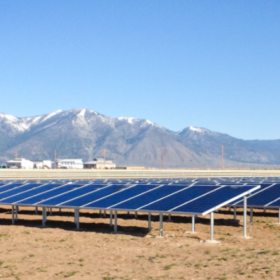California researchers observe perovskite degradation at nano-scale
A group of researchers led by the University of California San Diego (UCSD) has utilized a novel technique to delve deep into hybrid perovskite materials without damaging. The team was able to observe ion migrations within material, which reduced its efficiency as a solar cell material.
Lazard shows ongoing cost declines in solar (w/ charts)
The consultancy’s 2017 study finds that the global cost of utility-scale solar has reached an unsubsidized LCOE of under $50 per megawatt-hour, making new solar cost-competitive with running existing coal or nuclear plants.
Berkeley scientists boost battery capacities
Scientists at the U.S. Department of Energy’s Lawrence Berkeley National Laboratory have made progress with cathodes made from ‘disordered’ materials, a technology which could greatly increase the storage capacity of lithium batteries.
Canadian Solar subsidiary Recurrent Energy signs deal for 100 MW project
Recurrent Energy, a wholly owned subsidiary of heavyweight module manufacturer Canadian Solar has signed power purchase agreement for a 100 MW PV project to be located in Kings County, Central California.
Stanford & DOE research brings insight into perovskite efficiency
Scientists at the Department of Energy’s SLAC National Accelerator Laboratory have published research revealing unusual atomic motions in perovskite materials exposed to light. The discovery, says Stanford, could prove crucial to further increasing the efficiency potential for perovskite solar cells.
Siemens and AES Corporation create new energy storage company Fluence
Fluence is the name of the collaboration between the German technology firm and global power company AES Corporation. New company will roll out Advancion and Siestorage energy platforms globally.
California’s C&I solar sector thrown into chaos with TOU changes
California regulators are proposing to move C&I customers onto pending time-of-use rates starting on August 1 – despite a lack of clarity as to the details of those rates.
U.S. cities move forward on the Energy Transition, without Trump
The annual U.S. Conference of Mayors has endorsed a 100% renewable energy target for 2035, electrification of transport and other measures, following 31 cities setting or already meeting 100% renewable energy goals.
EDF signs 15-year PPA for 500 MW plant in the United States
Southern California Edison will purchase 125 MW AC from the Maverick Solar (formerly Palen 1) Plant, which is expected to start delivering electricity on Dec. 1, 2020.
U.S. energy storage market grows nearly 10-fold by MWh during Q1
A surge in California’s market driven by the Aliso Canyon gas leak is behind much of the boom, as deployment shifts to longer-duration energy storage.










